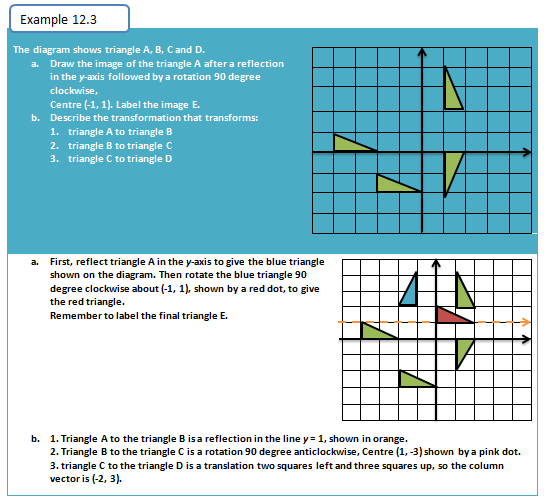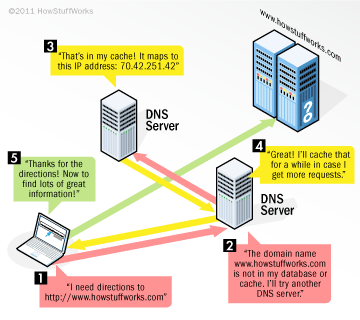A
locus is a set of points that follow a given rule. The plural of locus is loci.
You need a ruler and compass to draw a locus accurately
Kamis, 27 Februari 2014
12.4 Enlarging Shapes
When
you enlarge a shape, all the lengths of the sides of the shape increase in the
same proportion. This is called the scale factor. All the angles in the shape
stay the same size.
When
you describe an enlargement you must give:
- The scale factor of the enlargement.
- The position f the centre of the enlargement
12.3 Transforming Shapes
You
can use a combination of reflections, translations and rotations to transform a
shape. You can also describe the transformation that maps an object onto its
image.
To
describe a reflection you must give:
- the equation of the mirror line
To
describe a translation you must give:
- the column vector
To
describe a rotation you must give:
- the centre of rotation
- the number of degrees of rotation (or fraction of whole turn)
- the direction of the reaction (clockwise or anticlockwise)
12.2 Solving Transformation Problems
When
a shape undergoes any of these three transformations it only changes its
position. Its shape and size stay the same. Under these three transformations,
an object and its image are always congruent.
When
you reflect a shape on a coordinate grid you need to know the equation of the mirror
line.
All
vertical lines are parallel to the y-axis and have the equation x=’a number’
All
horizontal lines are parallel to the x-axis and have the equation y=’a number’
Some
examples are shown on the grid on the right.
When
you rotate a shape on a coordinate grid you need to know the coordinates of the
centre of rotation, and the size and direction of the turn.
When
you translate an example of a column vector: 4,5
The
top number states how many units to move the shape right (positive number) or
left (negative number). The bottom states how may units to move the shape up (positive
number) or down (negative number)
For
example:
(4,5) means : ‘move the shape 4 units right and 5 units up’
(-2,-3) means: ‘move the
shape 2 units left and 3 units down’
You
can see any these three transformations to solve all sorts of problem
12.1 Tessellating Shapes
A tessellation is a pattern of identical shapes. You can
make your own tessellation by fitting copies of a shape together, without gaps
or overlap. You say the shape tessellates, or a tessellating shape. Here are
some examples of shapes that tessellate with themselves.
Here are some examples of shapes that do not shape with
themselves. There are gaps between the shapes.
When you make a tessellation you can move the shape by
translating, rotation or reflecting it.
Many tessellations are made by repeating a shape and using
half-turn rotations of the same shape.
For example, this triangle
and using half-turn rotations of the same triangle fit together exactly to make a tessellation like this:
In any tessellation, the sum of the angles at
the point where the vertices of the shapes meet is 360 degree. Look closely at
three of the tessellations above.
Rabu, 26 Februari 2014
Water Cleaning Projet
FAPIPS Water Cleaning Organization from Al-Taqwa College Indonesia would like to introduce our plan
Program: Water Cleaning
Name of organization: FAPIPS water cleaning
Slogan: Air bersih, kita senang.
Aim: We want to help the people who live nearby the Citarum river get clean water.
Location: Citarum River, Bekasi, Indonesia
How to reach there: Voluntary transportation with the help of google map.
Reason: The people of Citarum are lacking of clean water.
Problem: Citarum river is covered in rubbish so that no clean water can be obtain.
Solution: Clean the river from the rubbish.
Steps:
1. Persuade the society to cooperate by stop littering.
2. Pick up all the rubbish in the river in order to clean it.
3. Cooperate with a company in Citeureup to recycle the rubbish.
4. Get a sponsor.
5. Cooperate with the government to support our program.
((FAPIPS stands for Fatimah, Angela, Putri, Indah, Prstina, Shoffa. These are the main members.)
Program: Water Cleaning
Name of organization: FAPIPS water cleaning
Slogan: Air bersih, kita senang.
Aim: We want to help the people who live nearby the Citarum river get clean water.
Location: Citarum River, Bekasi, Indonesia
How to reach there: Voluntary transportation with the help of google map.
Reason: The people of Citarum are lacking of clean water.
Problem: Citarum river is covered in rubbish so that no clean water can be obtain.
Solution: Clean the river from the rubbish.
Steps:
1. Persuade the society to cooperate by stop littering.
2. Pick up all the rubbish in the river in order to clean it.
3. Cooperate with a company in Citeureup to recycle the rubbish.
4. Get a sponsor.
5. Cooperate with the government to support our program.
((FAPIPS stands for Fatimah, Angela, Putri, Indah, Prstina, Shoffa. These are the main members.)
Senin, 17 Februari 2014
What Should You Do as The Next President?
Dear Mr. ....,
Our names are Indah and Pristina. We would like to ask you some questions since we know that you are one of the nominees of Indonesia’s Next Presidents.
As we know that Indonesia is going to have a democracy party on April 9 2014. Every citizen has the right to choose their own choice for a leader. There are many president candidates that are willing to be presidents and you are one of them.
If you really are willing to be the next President of Indonesia, then we have some questions for you.
Us, as Indonesian citizens surely want a leader who can develop Indonesia and make Indonesia as a better country.
1. In your opinion, are you really sure to be the next president of Indonesia 2014-2019 that is going to be chose by the citizens through the election?
According to political observer from University of Indonesia, Andrinof Chaniago predicted that the amount of citizens who don’t take the right to vote their leader will increase.
“The amount of citizens who don’t take the right to vote can increase from 35 up to 40 percent.” said Andrinof when he was contacted by Kompas.
We think that this might be the proof that Indonesian citizens don’t care about the future of Indonesia. Do you think you can be the next president of Indonesia in this condition?
And then our next question is:
2. What is the first thing that you will do when you become the president of Indonesia?
We know that being the president of Indonesia with 240 million citizens and many islands can’t be easy. To us, it’s very hard to just be a leader in the classroom. If being a leader in a classroom is hard, how about ruling millions of citizens from many tribes and cultures? We can’t imagine it, it must be really hard. It’s a big challenge.
We want the next president of Indonesia to not take the wrong step in every of his action and duty. The next president of Indonesia should be sure and aware of all the risks from his deed. We really want to have Indonesia developed. Just like Japan and Singapore. If Japan and Singapore can be developed then Indonesia should be able to be developed too!
The third question:
3.Can you assure that when you become the next President of Indonesia, Indonesia will be free from corruption?
It's pathetic to see and hear the legendary and phenomenal news on the television until very recently.Whenever there is a new hot topic, it must be about corruption. Corruption news has been the trending topic of Indonesia. Indonesia must be lead by a leader who has a strong faith and iman. Corruption is a shameful act. Verily, corruption disadvantage not only oneself, but every citizen of Indonesia. If the next leader is a corruptor, what will happen to the future of Indonesia? One can't be a president of the country, if he can't even be a president to himself. A leader must be firm and be a role model to the citizens.
It's an honor for us as students, if you can answer our 3 questions.
Because we hope that Indonesia will have a deserving President to lead Indonesia. So that one day, Indonesia can be a developed country.
Thank You.
Sincerely,
Pristina and Indah.
Kamis, 13 Februari 2014
IT
WAN Technology
Stands for Wide Area Network is similar to a Local
Area Network (LAN), but it's a lot bigger. Unlike LANs, WANs are not limited to
a single location. Many wide area networks span long distances via telephone
lines, fiber-optic cables, or satellite links. They can also be composed of
smaller LANs that are interconnected. The Internet could be described as the
biggest WAN in the world.
Frame Relay –is A packet-switched technology of 64Kbps up to 45Mbps
(T3).it provides features for dynamic bandwidth allocation and congestion
control.
PPP - PPP can be used to create point-to-point links between
different vendors’ equipment.
PPP Facts
- It can be used on a wide variety of physical interfaces
including asynchronous serial, synchronous serial (dial up), and ISDN.
- It supports multiple Network layer protocols, including
IP, IPX, AppleTalk, and numerous others.
- Optional authentication is provided through PAP (2-way
authentication) or CHAP (3-way authentication).
- It supports multilink connections, load-balancing
traffic over multiple physical links.
- It includes Link Quality Monitoring (LQM) which can
detect link errors and automatically terminate links with excessive
errors.
- It includes looped link detection that can identify
when messages sent from a router are looped back to that router. This is
done through routers sending magic numbers in communications. If a router
receives a packet with its own magic number, the link is looped.
PPP uses two main
protocols to establish and maintain the link.
TCP/IP (7 OSI Layers)
Transmission Control Protocol/Internet Protocol, the suite
of communications
protocols used to connect hosts on the Internet. TCP/IP uses several protocols, the two main ones being TCP and IP. TCP/IP is built into the UNIX operating
system and is used by the
Internet, making it the de facto
standard for transmitting data over networks.
The OSI, or Open System Interconnection, model defines a
networking framework to implement protocols in
seven layers. Control is passed from
one layer to the next, starting at the application layers in one station, and
proceeding to the bottom layer, over the channel to the next station and back
up the hierarchy.
DNS
Short for Domain Name System (or Service or Server), an
Internet service that translate domain names into IP addresses. Because
domain names are alphabetic, they're easier to remember. The Internet
however, is really based on IP
addresses. Every time you
use a domain name, therefore, a DNS service must translate the name into the
corresponding IP address.
Langganan:
Postingan (Atom)












